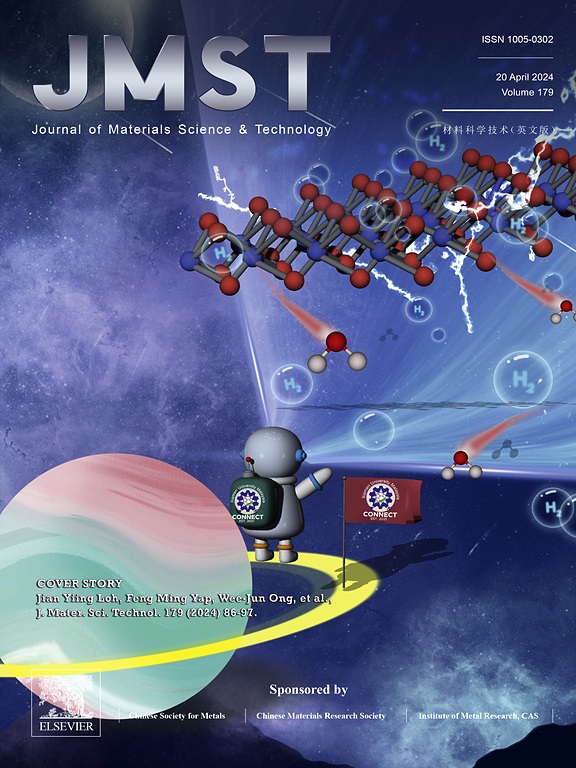Local strain fluctuations enable sluggish martensitic transformation in additively manufactured NiTi alloys with 〈001〉 growth texture under tensile loading
IF 14.3
1区 材料科学
Q1 MATERIALS SCIENCE, MULTIDISCIPLINARY
引用次数: 0
Abstract
Implementing additive manufacturing to NiTi (Nitinol) alloys typically enables a preferred 〈001〉B2 texture along the building direction. Unfortunately, this growth orientation always possesses a high critical stress level to induce the martensitic transformation and experiences premature failure before the formation of martensite during tensile testing. By utilizing in situ characterization technologies, in this study, we demonstrate that by fabricating a NiTi sample with complete 〈001〉B2 texture using wire-fed electron beam directed energy deposition, a sluggish martensitic transformation can be achieved to retard the initiation of fracture under tensile loading. To discern the origins of this tensile response, we combine experiments with molecular dynamics simulations to systematically analyze the micro-scale details on how internal lattice defects can select the variety of martensite variants. Using both quasi in situ transmission electron microscopy analysis and calculations of the different atomic configurations, our results indicate that the pre-existing precipitates and accumulated dislocation defects, rather than columnar boundaries, can have a positive influence on the sluggish formation of variants that can couple with plastic deformation within a much wider stress interval. Specifically, only the variant favored by both internal strain/stress fluctuations around local defects and external tensile load will overcome the high-energy transition barrier of 〈001〉B2-oriented tension to nucleate and grow sluggishly. The current findings not only show how the mechanical responses can be controlled in additively manufactured NiTi alloys with 〈001〉B2 texture, but also regard this understanding to be a step forward in decoding the salient underlying mechanisms for the correlating texture, defects, and phase transformation of these functional materials.

局部应变波动使具有〈001〉生长纹理的添加式制造镍钛合金在拉伸加载下发生缓慢的马氏体转变
对NiTi (Nitinol)合金实施增材制造通常可以沿着建筑方向获得优选的< 001 > B2织构。不幸的是,这种生长取向在拉伸试验中总是具有高的临界应力水平来诱导马氏体转变,并且在马氏体形成之前就过早失效。通过原位表征技术,在本研究中,我们证明了通过使用线馈电子束定向能沉积制备具有完整< 001 > B2织构的NiTi样品,可以实现缓慢的马氏体转变,以延缓拉伸载荷下断裂的发生。为了辨别这种拉伸响应的起源,我们将实验与分子动力学模拟相结合,系统地分析了内部晶格缺陷如何选择各种马氏体变体的微观细节。使用准原位透射电镜分析和不同原子构型的计算,我们的结果表明,预先存在的沉淀和累积的位错缺陷,而不是柱状边界,可以对在更宽的应力区间内与塑性变形耦合的变异体的缓慢形成产生积极影响。具体来说,只有局部缺陷周围的内部应变/应力波动和外部拉伸载荷都有利的变形才会克服< 001 > b2取向张力的高能转变势垒而成核并缓慢生长。目前的研究结果不仅表明了如何控制增材制造的< 001 > B2织构的NiTi合金的力学响应,而且还认为这一理解是在破解这些功能材料的相关织构、缺陷和相变的显着潜在机制方面迈出了一步。
本文章由计算机程序翻译,如有差异,请以英文原文为准。
求助全文
约1分钟内获得全文
求助全文
来源期刊

Journal of Materials Science & Technology
工程技术-材料科学:综合
CiteScore
20.00
自引率
11.00%
发文量
995
审稿时长
13 days
期刊介绍:
Journal of Materials Science & Technology strives to promote global collaboration in the field of materials science and technology. It primarily publishes original research papers, invited review articles, letters, research notes, and summaries of scientific achievements. The journal covers a wide range of materials science and technology topics, including metallic materials, inorganic nonmetallic materials, and composite materials.
 求助内容:
求助内容: 应助结果提醒方式:
应助结果提醒方式:


